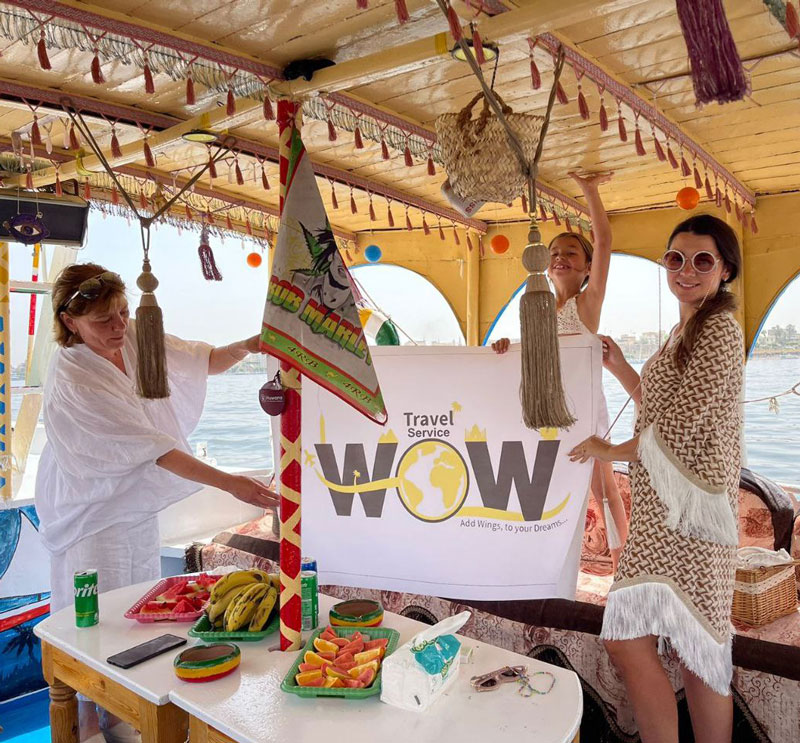Luxor by plane
- $200 for ages 12 and above
- $190 for children aged 6-11
- $150 for children aged 3-6 and children under 3 with a seat on the plane and bus
- Free for children under 3 if they do not occupy a seat on the plane and bus
- Transfer from the hotel to the airport around 4:00 AM, depending on the hotel's location (the flight takes about 1.5 hours).
- Flight from Sharm El Sheikh to Luxor.
- City of the Living: Visit to the Karnak Temple Complex (scarab beetle statue, sacred lake).
- Boat ride to the other side of the Nile.
- Lunch at a riverside restaurant (buffet).
- City of the Dead: Colossi of Memnon, Valley of the Kings, visit to the Temple of Queen Hatshepsut.
- Optional boat trip to Banana Island (booked with the guide).
- Stone products factory / perfume factory.
- Flight from Luxor to Sharm El Sheikh.
- Transfer from the airport, arrival at the hotel around 9:00 PM.
*The order of activities may vary depending on the flow of tourists.
- Passport.
- Headgear.
- Sunglasses.
- Sunscreen.
- Comfortable footwear.
- Warm clothing in winter months.
- Money for personal expenses.
- An Egyptian visa is required. If you only have a Sinai stamp, we can assist you in obtaining a tourist visa before the excursion. Cost: $30, $25 for the visa, and $5 for our services.
- Booking at least 2 days in advance.
- Prepayment of $100 per person to purchase plane tickets, non-refundable in case of cancellation of the excursion.
Included:
- Transportation service.
- Plane tickets for the Hurghada - Luxor - Hurghada route.
- Guide - egyptologist.
- Entrance tickets.
- Lunch at a restaurant.
Not included:
- Additional expenses not included in the program.
- Beverages at the restaurant.
- Boat trip to Banana Island - $10.
Luxor is rightfully considered the largest open-air museum, with its name derived from the Arabic “El-Uksur,” meaning “palaces.” The Nile River divides the city into two parts: the right (eastern) bank, known as the “City of the Living,” and the left (western) bank, known as the “City of the Dead.”
We offer various excursion programs that include the most interesting attractions, but it is impossible to cover everything within the framework of standard group excursions. For those who wish to see more, we organize individual tours in Luxor.
The Karnak Temple Complex covers an area of 1.5 km by 700 m. The construction of the complex began in the 20th century BC and lasted for 13 centuries. Karnak is the only temple consisting of 10 halls and having 10 gates (pylons). The statue of the scarab beetle, which according to legend grants wishes, and the sacred lake measuring 129 by 77 m and used in the past for ritual ablutions, are of particular interest during the excursions. The sacred path, represented by an avenue of sphinxes, leads from the Karnak Temple Complex to the Luxor Temple.
The Colossi of Memnon are the only surviving remnants of the temple of Amenhotep III, built around 1400 BC. The temple was completely destroyed by an earthquake around 1200 BC, but the colossi remained. Another strong earthquake in the 27th century BC partially destroyed the left statue, and at sunrise, the colossus began to sing. However, after the restoration of the colossus in 199 AD, the singing ceased.
The tombs in the Valley of the Kings were used from the 16th to the 11th century BC. Currently, more than 50 pharaohs’ tombs have been excavated, but archaeological excavations are ongoing. The most famous tomb, that of Tutankhamun, was discovered in 1922 and became the basis for the legend of the “Curse of the Pharaohs.”
The Temple of Queen Hatshepsut was built between 1482 and 1473 BC. The ancient name of the temple, Djeser-Djeseru, translates to “Holiest of Holies.” The temple of the female pharaoh was a place of pilgrimage where people left requests for assistance or healing from diseases on the walls.
During the visit to Banana Island, you can see not only how bananas grow but also other fruits such as mangoes and mandarins, as well as sugar cane, mint, and various spices. There is a cafe on the island where freshly picked bananas will be offered to you for free, and you can also pick them directly from the “banana tree” (bush) during your walk on the island.
The stone products factory (alabaster factory) partly resembles a museum. During the visit, you will learn about the technology of producing alabaster products and find out how genuine alabaster items differ from imitations. If desired, you can purchase souvenirs made of genuine stone.
At the perfume factory, the guide will explain the manufacturing techniques of oils and perfumes. The factory’s shop offers high-quality oils and oil-based perfumes for sale.









